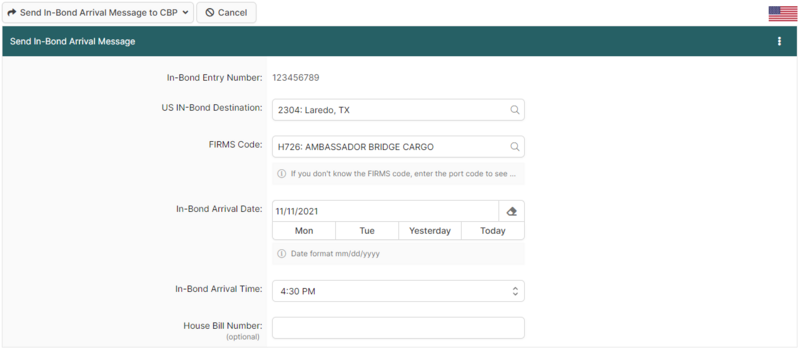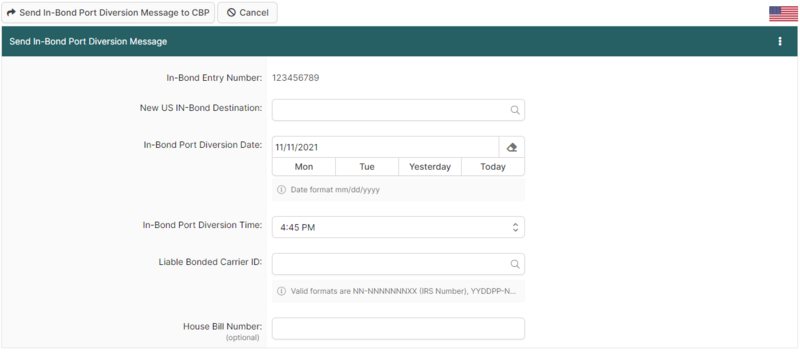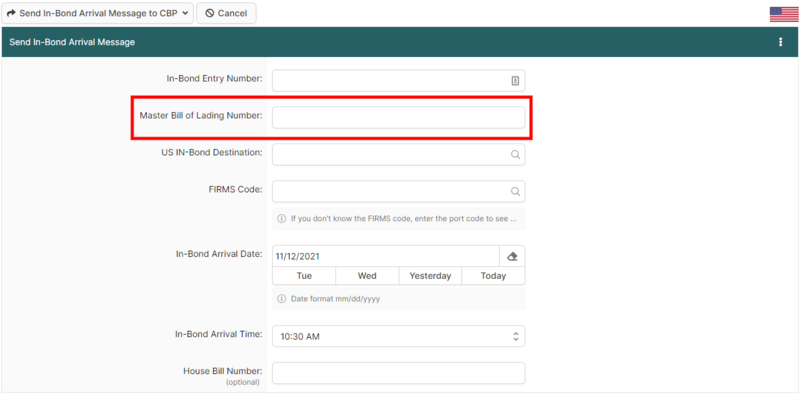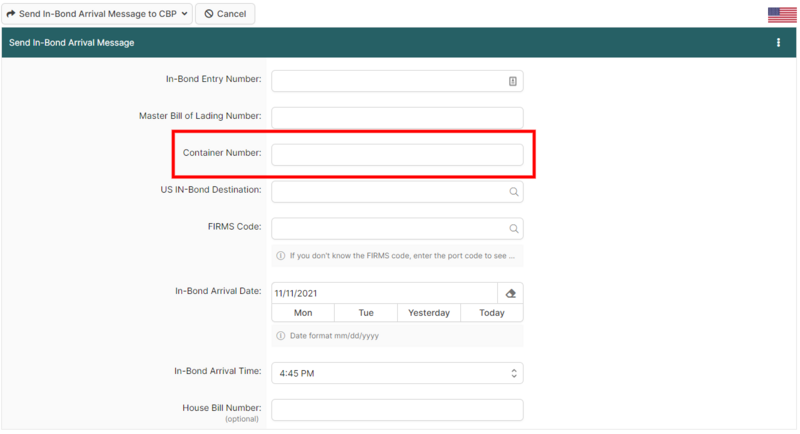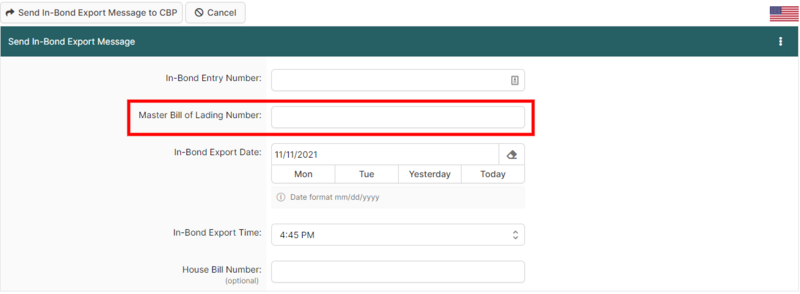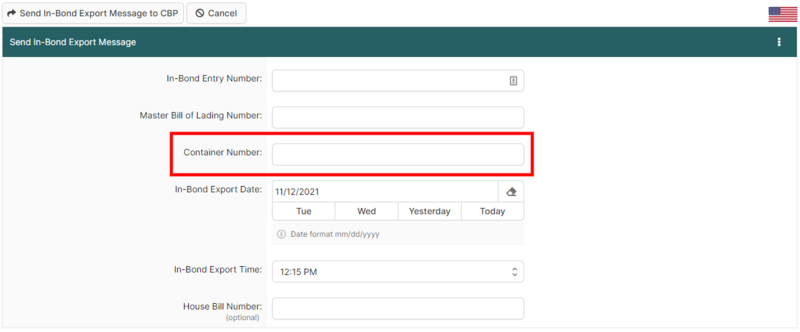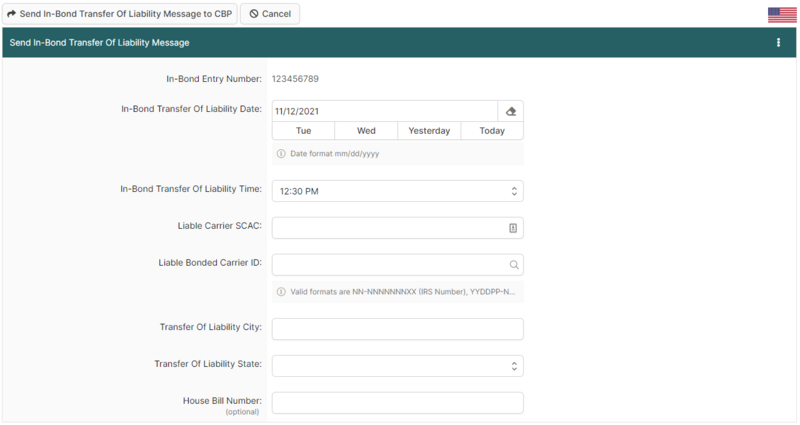Reporting In Bond Arrivals and Exports (U.S. In-Bond Manager)
| This article is part of the BorderConnect U.S. In-Bond Manager Guide |
This guide offers instructions on reporting arrivals and exports of in-bond shipments using BorderConnect's U.S In-Bond Manager. BorderConnect U.S. In-Bond Manager allows users to electronically report in-bond arrivals and exports to US Customs and Border Protection. This guide also covers Port Diversion requests and Transfers of Liability.
Reporting In-Bond Arrivals
The Send In-Bond Arrival Message to CBP page is used for electronic reporting of in-bond arrival. This page can be accessed by choosing Arrive Entire In-Bond from the In-Bond Report Details Page, or from the main menu under U.S. In-Bonds. It is easier to complete from the in-bond report if possible, because this pre-fills some of the fields for you.
- In-Bond Entry Number
- The main number identifying the in-bond to CBP. Should be 9 numeric digits, with no spaces, dashes or other characters. This field will be pre-filled if you are arriving the in-bond from the in-bond report.
- US In-Bond Destination
- The CBP port that the in-bond movement is destined to. Must match the destination port of the in-bond itself. This field will be pre-filled if you arriving the in-bond from the in-bond report if the destination port is known, otherwise you can bring up port options by typing the port code or port name.
- FIRMS Code
- The CBP facility number for the specific location the in-bond is arriving at. If you don't know the FIRMS code, you can type the port code that you entered above to see a list of options for your destination port. If your shipment has already crossed into Canada, you should choose one of the options marked as a CBP Port of Exit, which will appear at the top of your results.
- In-Bond Arrival Date
- The date that the in-bond shipment arrived at the destination port. This date must not be in the future, as the in-bond arrival cannot be reported before it happens. In-bond arrivals are required by regulation to be reported within 2 business days.
- In-Bond Arrival Time
- The specific time the in-bond shipment arrived at the destination port.
- House Bill Number
- Only used for in-bonds with the Air mode of transport. Not required.
Reporting In-Bond Exports
The Send In-Bond Export Message to CBP page is used for electronic reporting of in-bond export. This page can be accessed by choosing Export Entire In-Bond from the In-Bond Report Details Page, or from the main menu under U.S. In-Bonds. It is easier to complete from the in-bond report if possible, because this pre-fills some of the fields for you.
- In-Bond Entry Number
- The main number identifying the in-bond to CBP. Should be 9 numeric digits, with no spaces, dashes or other characters. This field will be pre-filled if you are exporting the in-bond from the in-bond report.
- In-Bond Export Date
- The date that the in-bond shipment was exported from the U.S., or was delivered to a place where export was reasonably assured. (For example at a seaport, airport or rail location and under control of the exporting carrier.) This date must not be in the future, as the in-bond export cannot be reported before it happens. In-bond exports are required by regulation to be reported within 2 business days.
- In-Bond Export Time
- The specific time the in-bond shipment was exported from the U.S. or was delivered to a place where export was reasonably assured.
- House Bill Number
- Only used for in-bonds with the Air mode of transport. Not required.
Making In-Bond Port Diversion Requests
The Send In-Bond Port Diversion page is used to request permission from CBP to change the in-bond destination port. This page can be accessed by choosing Send Port Diversion Request from the In-Bond Report Details Page, or from the main menu under U.S. In-Bonds. It is easier to complete from the in-bond report if possible, because this pre-fills some of the fields for you.
- In-Bond Entry Number
- The main number identifying the in-bond to CBP. Should be 9 numeric digits, with no spaces, dashes or other characters. This field will be pre-filled if you are sending the diversion request from the in-bond from the in-bond report.
- New US In-Bond Destination
- The new CBP port that you want for the in-bond destination. You can bring up port options by typing the port code or port name.
- In-Bond Diversion Date
- The effective date for the new in-bond destination port.
- In-Bond Diversion Time
- The effective time for the new in-bond destination port.
- Liable Bonded Carrier ID
- The number identifying the bond holder of this in-bond shipment to CBP. If you have already used this field previously, you can hit space to see a list of options. Valid formats for the In-bond Carrier Identification codes are: NN-NNNNNNNXX (Internal Revenue Service (IRS) Number), YYDDPP-NNNNN (USCBP Assigned Number), and NNN-NN-NNNN (Social Security Number)
- House Bill Number
- Only used for in-bonds with the Air mode of transport. Not required.
Reporting Arrivals Using Bill of Lading
It is also possible to report the arrival of one portion of an in-bond, using the bill of lading number. For in-bonds that have multiple bills of lading, this notifies CBP that only a portion of the in-bond has arrived at the destination port. For in-bonds that have only a single bill of lading, this is effectively the same as arriving the entire in-bond, so it's recommended to use that option instead.
To arrive by bill of lading, you can select that option under Send WP Request on the In-Bond Report Details Page, or select that option from under the U.S. In-Bonds menu.
When arriving the in-bond by bill of lading, all the fields are the same as described above, expect the Master Bill of Lading field is added. This is the bill of lading number that you wish to arrive on the in-bond. When arriving by bill of lading from the in-bond report, this field will be pre-filled.
Reporting Arrivals Using Container Number
Another option is to report the arrival of a specific container on an in-bond, using the container number. For in-bonds that have multiple containers, this notifies CBP that only a portion of the in-bond has arrived at the destination port.
To arrive by container, you can select that option under Send WP Request on the In-Bond Report Details Page, or select that option from under the U.S. In-Bonds menu.
When arriving the in-bond by container, all the fields are the same as described above, expect the Master Bill of Lading and Container Number fields are added. The master bill of lading number is the bill of lading number that the container is associated with, and the container number is the one that you wish to arrive on the in-bond. When arriving by container from the in-bond report, the master bill of lading number field will be pre-filled.
Reporting In-Bond Exports Using Bill of Lading
It is also possible to report the export of one portion of an in-bond, using the bill of lading number. For in-bonds that have multiple bills of lading, this notifies CBP that only a portion of the in-bond has been exported from the U.S. For in-bonds that have only a single bill of lading, this is effectively the same as exporting the entire in-bond, so it's recommended to use that option instead.
To export by bill of lading, you can select that option under Send WP Request on the In-Bond Report Details Page, or select that option from under the U.S. In-Bonds menu.
When exporting the in-bond by bill of lading, all the fields are the same as described above, expect the Master Bill of Lading field is added. This is the bill of lading number that you wish to export on the in-bond. When exporting by bill of lading from the in-bond report, this field will be pre-filled.
Reporting In-Bond Exports Using Container Number
Another option is to report the export of a specific container on an in-bond, using the container number. For in-bonds that have multiple containers, this notifies CBP that only a portion of the in-bond has been exported from the U.S.
To export by container, you can select that option under Send WP Request on the In-Bond Report Details Page, or select that option from under the U.S. In-Bonds menu.
When exporting the in-bond by container, all the fields are the same as described above, expect the Master Bill of Lading and Container Number fields are added. The master bill of lading number is the bill of lading number that the container is associated with, and the container number is the one that you wish to export on the in-bond. When exporting by container from the in-bond report, the master bill of lading number field will be pre-filled.
Transferring In-Bond Liability
The Send In-Bond Transfer of Liability page is used to transfer liability for an in-bond from one bonded carrier to another. Please note this should only be done by the carrier accepting liability for the in-bond. It is not allowed to transfer liability from yourself to another party, and this could result in CBP penalties. This page can be accessed by choosing Send Transfer of Liability Request from the In-Bond Report Details Page, or from the main menu under U.S. In-Bonds. It is easier to complete from the in-bond report if possible, because this pre-fills some of the fields for you.
- In-Bond Entry Number
- The main number identifying the in-bond to CBP. Should be 9 numeric digits, with no spaces, dashes or other characters. This field will be pre-filled if you are sending the transfer of liability request from the in-bond from the in-bond report.
- In-Bond Transfer Of Liability Date
- The effective date for the transfer of liability.
- In-Bond Transfer Of Liability Time
- The effective time for the transfer of liability.
- Liable Carrier SCAC
- The SCAC code of the carrier accepting liability for the in-bond.
- Liable Bonded Carrier ID
- The number identifying the bond holder accepting liability for this in-bond shipment to CBP. If you have already used this field previously, you can hit space to see a list of options. Valid formats for the In-bond Carrier Identification codes are: NN-NNNNNNNXX (Internal Revenue Service (IRS) Number), YYDDPP-NNNNN (USCBP Assigned Number), and NNN-NN-NNNN (Social Security Number)
- Transfer Of Liability City
- The city at which the transfer of liability is taking place.
- Transfer Of Liability State
- The U.S. state in which the transfer of liability is taking place.
- House Bill Number
- Only used for in-bonds with the Air mode of transport. Not required.

